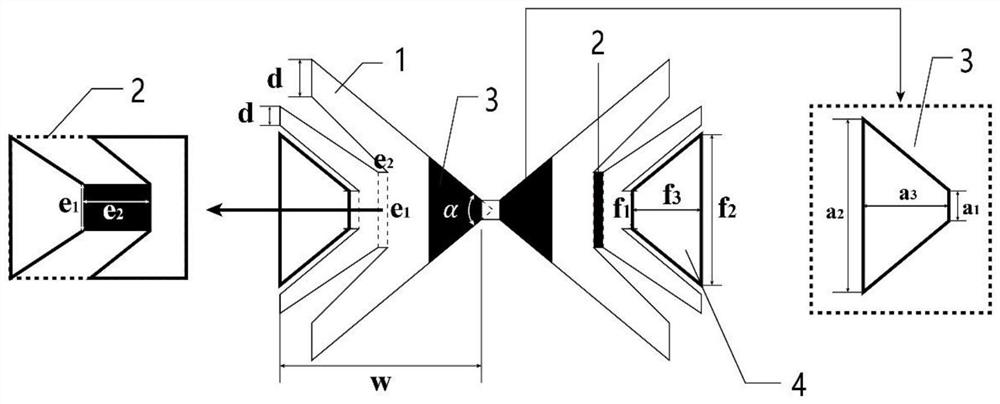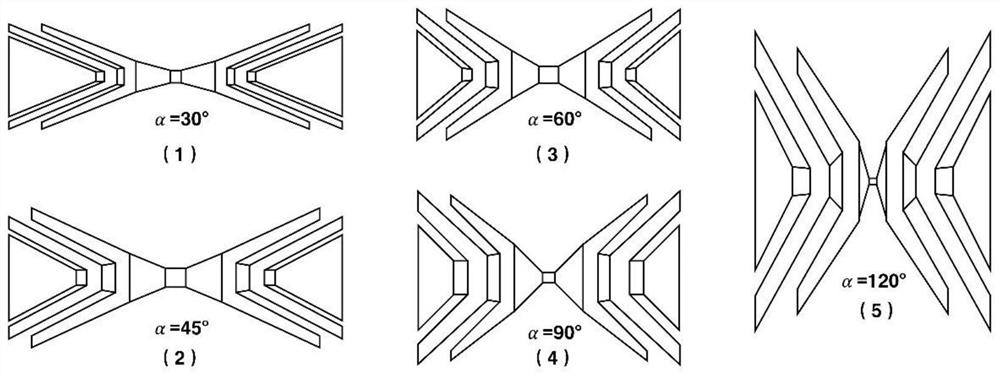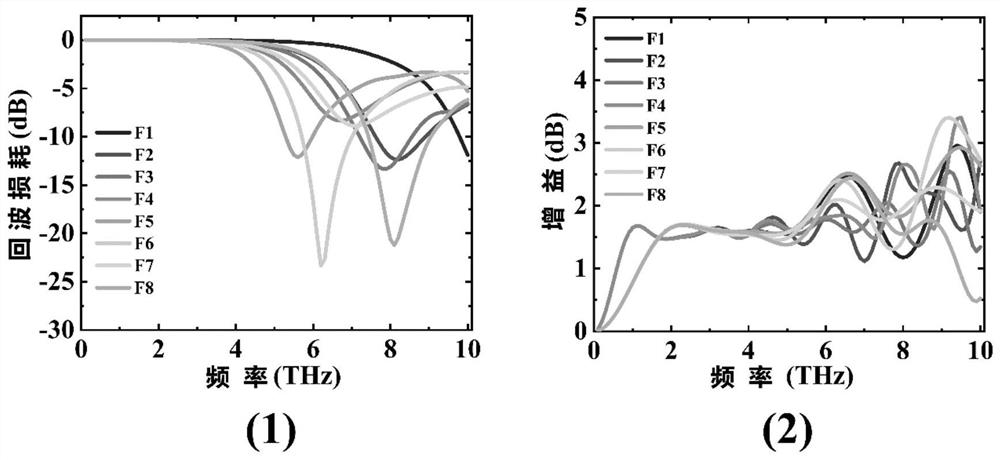Fractal butterfly-shaped terahertz antenna
A terahertz and fractal technology, which is applied in the field of terahertz detection and terahertz communication, can solve problems such as energy loss, uneven electric field distribution, and current congestion, and achieve the effects of increased efficiency, simple planar structure, and stable broadband performance
- Summary
- Abstract
- Description
- Claims
- Application Information
AI Technical Summary
Problems solved by technology
Method used
Image
Examples
Embodiment 1
[0025] In the 0.1THz-10THz band range, the fractal butterfly antenna can be self-adjusted according to the size requirements of antennas in different frequency bands to achieve the best antenna coupling efficiency. The scalability of the fractal butterfly antenna enables it to be flexibly applied to multiple frequency bands and reduces the design cost of the antenna.
[0026] Aiming at the number of fractal units used, the fractal units were increased from 1 to 8, and the simulation calculations were carried out one by one, and the results were obtained for analysis. in image 3 (1) is a comparison chart of return loss of 8 groups of antennas; (2) is a graph of gain curves corresponding to 8 groups of antennas. As the number of fractal units increases, the resonance point of the antenna is getting closer to the center frequency point. When the fractal unit of the antenna increases to a certain number under a certain range of sizes, the resonance point will start to move away...
Embodiment 2
[0028] in Figure 4 (1) is the reflection loss diagram of the fractal butterfly antenna when the number of fractal units is 3 and 4. When there are 3 pairs of fractal units, the antenna resonates at 6.2-6.3THz and has a return loss of -23.33dB.
[0029] When there are 4 pairs of fractal units, the antenna resonates at 6.2-6.4THz and has a return loss of -13.37dB.
[0030] For the two groups of antennas, the 3-group shaped element and the 4-group shaped element, the return loss data obtained by parameter optimization is compared, for example Figure 4 (2) shown. After parameter optimization, the antenna with three-component shaped elements resonates at a frequency close to the center frequency of 4.9THz, the maximum return loss reaches -33.59dB, and two peaks appear. The antenna of the 4-group shaped element resonates at a frequency close to the center frequency of 5.4THz, and the maximum return loss reaches -34.19dB. There are also two peaks, but the amplitude of the second...
Embodiment 3
[0032] In the present invention, the proposed fractal butterfly antenna adopts two different materials of gold and graphene to simulate and compare. Such as Figure 5 It is the simulation data graph (gain graph, VSWR, S11) of the fractal butterfly antenna using gold and graphene as materials respectively, where graph (1) is a data comparison graph of the antenna gain of two materials; where graph (2) is two The data comparison chart of the VSWR of the material antenna; the figure (3) is the data comparison chart of the return loss of the two material antennas. For the fractal butterfly antenna proposed by the present invention, the simulation results of the graphene material are not much different from the simulation results of gold. The antenna structure proposed by the present invention can weaken the difference in antenna performance caused by materials, and provides more possibilities for material selection of terahertz detectors. The fractal butterfly antenna proposed b...
PUM
 Login to View More
Login to View More Abstract
Description
Claims
Application Information
 Login to View More
Login to View More - R&D
- Intellectual Property
- Life Sciences
- Materials
- Tech Scout
- Unparalleled Data Quality
- Higher Quality Content
- 60% Fewer Hallucinations
Browse by: Latest US Patents, China's latest patents, Technical Efficacy Thesaurus, Application Domain, Technology Topic, Popular Technical Reports.
© 2025 PatSnap. All rights reserved.Legal|Privacy policy|Modern Slavery Act Transparency Statement|Sitemap|About US| Contact US: help@patsnap.com



